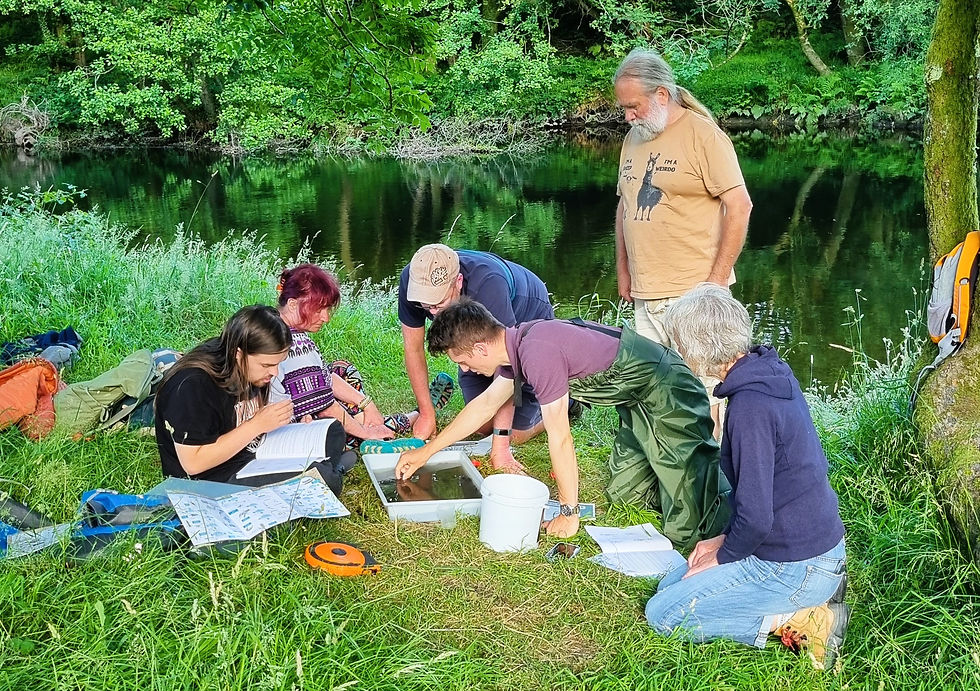The Dyfi Biosphere, a learning community
- dyfibiosphere
- Aug 13, 2024
- 3 min read
Did you know that Education is the E in UNESCO? It's always been central to our work. One of the Dyfi Biosphere Education Group's favourite tools is a set of aerial photographs of the area, seen here at Ysgol Plascrug earlier this year. Laid out in a school hall, it is big enough to show the patchwork of fields, woods, lakes, mountains and sea that make up our part of the global Biosphere.

From there we discuss how human activities and the environment can work together, through specific examples. What’s important about the Dyfi Biosphere Education Group is the practice of joint working. Rather than competing for the attention of teachers, we have had RSPB Ynys Hir, the Centre for Alternative Technology, the Montgomeryshire Wildlife Trust, LEAF Education, Dyfi Woodlands and others creating a shared programme. That meant that learners got to study not just wildlife, renewable energy and farming, for instance, but also the links - and the tensions - between them.
This year, funding from Welsh Government and UNESCO UK’s Local to Global project (thanks to the National Heritage Lottery Fund) has enabled us to refresh our activities. A meeting of a dozen education providers in January showed the enthusiasm that there is for the Biosphere concept, while two teacher webinars with Powys Eco Schools in the spring allowed us to find out what teachers need. Finally, three all-day Biosphere sessions in schools in July were an opportunity to see how young people respond.
From this, I think three conclusions emerged.
One is the power of the Biosphere to bring education providers together. The UNESCO designation gives extra purpose to place-based education, creating a community of learning in which new thinking can emerge. It also provides a global context.
Another is how important it is to support our teachers. They were emphatic that they wanted external input, whether by welcoming experts into school or taking their learners on site visits. However, resources will always be limited, and some of the effort needs to go into training them to embed Biosphere messages into their own teaching. A good example here is the ‘Our City, Our World’ programme linked to the Living Coast Biosphere in Brighton and Hove.
Here, we could make more use of the Eco Schools framework, which has been designed with the same collaborative approach, as well as linking to national initiatives, especially the Wales Council for Outdoor Learning and of course the Welsh curriculum which supports outdoor learning alongside ethical citizenship.
And finally there is the work on the ground, where children engage directly with the world around them. Although we often talk of education being ‘provided’ to children, it is ideally a two-way process. Children in Llanidloes schools for instance have been inspired by the Biosphere Swifts Project to put up nest boxes and help monitor the birds, while at Comins Coch primary school near Aberystwyth pupils recently conducted a wildlife survey along the new cycle path.

With the UNESCO funding, school pupils also looked at food production in the Biosphere, tasting honey from Wainwright’s Bee Farm and milk from Jenkins Milk, plus fruit and veg from small growers, learning more about the economy, as well as renewable energy and biodiversity.
Other providers have been active too. One school enjoyed a two-day camping expedition along the Dysynni led by local charity Art + Science. And Edible Mach have been running Prosiect Pizza in the Dyfi Valley for the last two years. Children grow and cook ingredients for pizza, local food heroes and growers run classroom and practical sessions on related topics, and the project culminates in July with each child making and eating a wood-fired pizza in the school garden.
How can we build on all this? The Biosphere could strengthen the first two elements in particular, drawing education providers and teachers together and supporting them to share ideas and develop a joint approach. This can then create a context in which individual actions - such as a visit to a nature reserve or a school gardening session in school - can have a greater effect. That means that the time and money that goes into these activities has a lasting benefit.
We are determined to build on the good work of the Education Group as the Biosphere moves into a new phase. There is still so much more we can do, not just for our local area but for all of Wales. What do you think?
By Jane Powell, Biosphere Coordinator. Images by the Biosphere and Edible Mach.






Comments